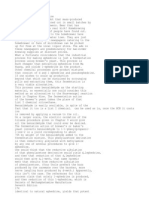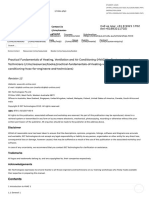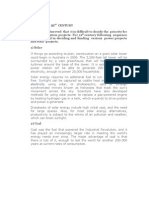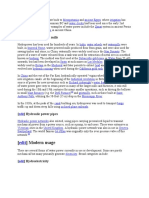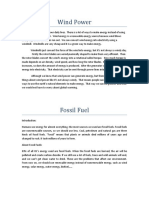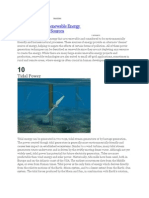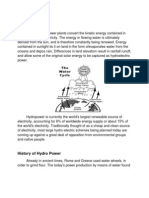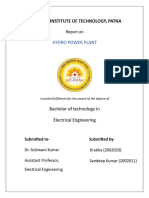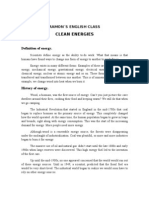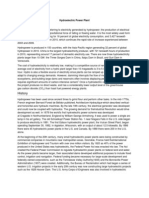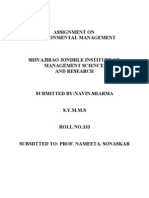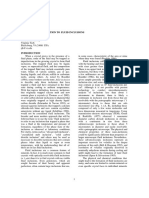Alternative Energy
Alternative Energy
Uploaded by
Sting MartinezCopyright:
Available Formats
Alternative Energy
Alternative Energy
Uploaded by
Sting MartinezCopyright
Available Formats
Share this document
Did you find this document useful?
Is this content inappropriate?
Copyright:
Available Formats
Alternative Energy
Alternative Energy
Uploaded by
Sting MartinezCopyright:
Available Formats
Alternative Energy: Fuel Cells and Hydropower.
Fuel Cells: Energy Source of the Future
A fuel cell is an electrochemical device that combines hydrogen and oxygen to produce electricity, with water and heat as its by-product. As long as fuel is supplied, the fuel cell will continue to generate power. Since the conversion of thefuel to energy takes place via an electrochemical process, not combustion, the process is clean, quiet and highly efficient two to three times more efficient than fuel burning. According to many experts, we may soon find ourselves using fuel cells to generate electrical power for all sorts of devices we use every day. A fuel cell is a device that uses a source of fuel, such as hydrogen, and an oxidant to create electricity from an electrochemical process. Much like the batteries that are found under the hoods of automobiles or in flashlights, a fuel cell converts chemical energy to electrical energy. All fuel cells have the same basic configuration; an electrolyte and two electrodes. But there are different types of fuel cells, based mainly on what kind of electrolyte they use. Many combinations of fuel and oxidant are also possible. The fuel could be diesel or methanol, while air, chlorine, or chlorine dioxide may serve as oxidants. Most fuel cells in use today, however, use hydrogen and oxygen as the chemicals. Fuel cells have three main applications: transportation, portable uses, and stationary installations. In the future, fuel cells could power our cars, with hydrogen replacing the petroleum fuel that is used in most vehicles today. Many vehicle manufacturers are actively researching and developing transportation fuel cell technologies.
Stationary fuel cells are the largest, most powerful fuel cells. They are designed to provide a clean, reliable source of on-site power to hospitals, banks, airports, military bases, schools, and homes. Fuel cells can power almost any portable device or machine that uses batteries. Unlike a typical battery, which eventually goes dead, a fuel cell continues to produce energy as long as fuel and oxidant are supplied. Laptop computers, cellular phones, video recorders, and hearing aids could be powered by portable fuel cells. Fuel cells have strong benefits over conventional combustion-based technologies currently used in many power plants and cars. They produce much smaller quantities of greenhouse gases and none of the air pollutants that create smog and cause health problems. If pure hydrogen is used as a fuel, fuel cells emit only heat and water as a byproduct. Hydrogenpowered fuel cells are also far more energy efficient than traditional combustion technologies. The biggest hurdle for fuel cells today is cost. Fuel cells cannot yet compete economically with more traditional energy technologies, though rapid technical advances are being made. Although hydrogen is the most abundant element in the universe, it is difficult to store and distribute. Canisters of pure hydrogen are readily available from hydrogen producers, but as of now, you can't just fill up with hydrogen at a local gas station. Many people do have access to natural gas or propane tanks at their houses, however, so it is likely that these fuels will be used to power future home fuel cells. Methanol, a liquid fuel, is easily transportable, like gasoline, and could be used in automobile fuel cells. However, also like gasoline, methanol produces polluting carbon dioxide. Hydropower: Going With the Flow
Hydropower is electricity generated using the energy of moving water. Rain or melted snow, usually originating in hills and mountains, create streams and rivers that eventually run to the ocean. The energy of that moving water can be substantial, as anyone who has been whitewater rafting knows.
This energy has been exploited for centuries. Farmers since the ancient Greeks have used water wheels to grind wheat into flour. Placed in a river, a water wheel picks up flowing water in buckets located around the wheel. The kinetic energy of the flowing river turns the wheel and is converted into mechanical energy that runs the mill. In the late 19th century, hydropower became a source for generating electricity. The first hydroelectric power plant was built at Niagara Falls in 1879. In 1881, street lamps in the city of Niagara Falls were powered by hydropower. In 1882 the worlds first hydroelectric power plant began operating in the United States in Appleton, Wisconsin. A typical hydro plant is a system with three parts: an electric plant where the electricity is produced; a dam that can be opened or closed to control water flow; and a reservoir where water can be stored. The water behind the dam flows through an intake and pushes against blades in a turbine, causing them to turn. The turbine spins a generator to produce electricity. The amount of electricity that can be generated depends on how far the water drops and how much water moves through the system. The electricity can be transported over long-distance electric lines to homes, factories, and businesses. Hydroelectric power provides almost one-fifth of the world's electricity. China, Canada, Brazil, the United States, and Russia were the five largest producers of hydropower in 2004. One of the world's largest hydro plants is at Three Gorges on China's Yangtze River. The reservoir for this facility started filling in 2003, but the plant is not expected to be fully operational until 2009. The dam is 1.4 miles (2.3 kilometers) wide and 607 feet (185 meters) high. The biggest hydro plant in the United States is located at the Grand Coulee Dam on the Columbia River in northern Washington. More than 70 percent of the electricity made in Washington State is produced by hydroelectric facilities. Hydropower is the cheapest way to generate electricity today. That's because once a dam has been built and the equipment installed, the energy sourceflowing wateris free. It's a clean fuel source that is renewable yearly by snow and rainfall. Hydropower is also readily available; engineers can control the flow of water through the turbines to produce electricity on demand. In addition, reservoirs may offer recreational opportunities, such as swimming and boating. Technologies like fish ladders help salmon go up over dams and enter upstream spawning areas, but the presence of hydroelectric dams changes their migration patterns and hurts fish populations. Hydropower plants can also cause low dissolved oxygen levels in the water, which is harmful to river habitats.
http://www.fuelcells.org/ http://environment.nationalgeographic.com/environment/energy/?source=NavEnvEnergy
You might also like
- BrewDocument17 pagesBrewXeronadazero67% (3)
- G8 Integrated Science NotesDocument41 pagesG8 Integrated Science NotesShanice Nyairo94% (17)
- Challenges of Coca-ColaDocument2 pagesChallenges of Coca-ColaSabrina ShailaNo ratings yet
- Practical Fundamentals of Heating, Ventilation and Air Conditioning (HVAC) For Engineers and Technicians PDFDocument387 pagesPractical Fundamentals of Heating, Ventilation and Air Conditioning (HVAC) For Engineers and Technicians PDFBruno de Rosso100% (1)
- Alternate Fuel Energy ResourcesDocument9 pagesAlternate Fuel Energy ResourcesMouse PotatoNo ratings yet
- Hydrogen As Energy Source PDFDocument3 pagesHydrogen As Energy Source PDFAlfredo Merizalde AvilesNo ratings yet
- Nuclear Fusion Loralins Project FinalDocument18 pagesNuclear Fusion Loralins Project Finalpumpy123No ratings yet
- Power For 21st CenturyDocument7 pagesPower For 21st CenturyPrakash Jagannath LakhapateNo ratings yet
- History of Hydroelectric Power in IndiaDocument18 pagesHistory of Hydroelectric Power in IndiaIshwari TiwariNo ratings yet
- Hydropower Seminar ReportDocument19 pagesHydropower Seminar Reportmichealfajobi7No ratings yet
- DemainDocument6 pagesDemainzaydinNo ratings yet
- Hydropower - Power Point PresentationDocument12 pagesHydropower - Power Point Presentationavg50% (2)
- Early Uses of Waterpower Date Back To Mia and Ancient EgyptDocument5 pagesEarly Uses of Waterpower Date Back To Mia and Ancient EgyptSailen BhattaNo ratings yet
- Research On Hydroelectric Power PlantDocument77 pagesResearch On Hydroelectric Power PlantVidya TalawarNo ratings yet
- Advantages and Disadvantages of Hydroelectric Power PlantDocument4 pagesAdvantages and Disadvantages of Hydroelectric Power PlantInternational Journal of Innovative Science and Research TechnologyNo ratings yet
- Water and Electricity ProductionDocument5 pagesWater and Electricity ProductiongopauleenreeseNo ratings yet
- Hydro Power Project..KamleshDocument29 pagesHydro Power Project..Kamleshkamlesh kumawatNo ratings yet
- 8 Energy Source Blurbs W.q'sDocument15 pages8 Energy Source Blurbs W.q'sNick WolfeNo ratings yet
- STUDENT 19 Hydroelectric PowerDocument3 pagesSTUDENT 19 Hydroelectric PowerNico Gillo ObejeroNo ratings yet
- Alternative Energy SourcesDocument5 pagesAlternative Energy SourcesStephanieNo ratings yet
- Hydroelectric Power PDFDocument4 pagesHydroelectric Power PDFryanNo ratings yet
- Everyboadys WordDocument5 pagesEveryboadys Word0106016jwongNo ratings yet
- Hydroelectric Energy Advantages and Disadvantages: American Journal of Energy ScienceDocument4 pagesHydroelectric Energy Advantages and Disadvantages: American Journal of Energy ScienceKalyana TarraNo ratings yet
- Hydroelectric Power Plants: Created By: Jasper Dickson Grade Level: High School Project Number: 38Document3 pagesHydroelectric Power Plants: Created By: Jasper Dickson Grade Level: High School Project Number: 38Logu12345No ratings yet
- Present Electricity GenerationDocument2 pagesPresent Electricity GenerationjamesNo ratings yet
- المحاضره الثامنهDocument3 pagesالمحاضره الثامنهMohammed MahmoodNo ratings yet
- Renewable Energy PaperDocument13 pagesRenewable Energy PaperBenjie Apostol-Collado Corachea-MindanaoNo ratings yet
- What Are Different Sources of EnergyDocument6 pagesWhat Are Different Sources of EnergyMeliza PugalNo ratings yet
- Renewable EnergyDocument56 pagesRenewable EnergyRana Muhammad TalhaNo ratings yet
- PhysciDocument27 pagesPhyscisophia lizarondoNo ratings yet
- Top 10 Renewable Energy Sources: Tidal PowerDocument9 pagesTop 10 Renewable Energy Sources: Tidal PowerSrinivasan KrishnamurtiNo ratings yet
- EM Booklet Year 2Document34 pagesEM Booklet Year 2libreriaelestudioNo ratings yet
- Environmental ConcersDocument4 pagesEnvironmental Concersamitgupta_foryouNo ratings yet
- Proiect Ces FinDocument11 pagesProiect Ces FinMadalina MolnarNo ratings yet
- Chapter 1:introduction: 1.1 Renewable EnergyDocument12 pagesChapter 1:introduction: 1.1 Renewable EnergyRamy Abd Elkhalek ShahinNo ratings yet
- Alternative Energy OverviewDocument8 pagesAlternative Energy OverviewSreten Žujkić PenzionerNo ratings yet
- Hydrogen Waves Tidal and BiomassDocument30 pagesHydrogen Waves Tidal and BiomassAref DahabrahNo ratings yet
- Hydro Power Plant - MergedDocument19 pagesHydro Power Plant - MergedSandeep SharmaNo ratings yet
- Alternative Sources of EnergyDocument6 pagesAlternative Sources of EnergykageNo ratings yet
- Renewable EnergyDocument5 pagesRenewable EnergyWalid MaheriNo ratings yet
- Clean Energies: Ramon S English ClassDocument7 pagesClean Energies: Ramon S English ClassRamón González TenderoNo ratings yet
- Hydroelectric Power (Hydropower) Micabalo, Troyo, BalbuenaDocument20 pagesHydroelectric Power (Hydropower) Micabalo, Troyo, Balbuenamaegeantroyo8No ratings yet
- Project Sample 01Document103 pagesProject Sample 01christoNo ratings yet
- Renewable and Nonrenewable Energy Sources Text TuesdayDocument3 pagesRenewable and Nonrenewable Energy Sources Text Tuesdayapi-330961162No ratings yet
- Module 2 - Class 8Document14 pagesModule 2 - Class 8josephsebastian6812No ratings yet
- Hydroelectric Power PlantDocument7 pagesHydroelectric Power PlantKristine Ann ReclosadoNo ratings yet
- How Energy Is Harnessed From Different Sources: A. Fossils FuelsDocument4 pagesHow Energy Is Harnessed From Different Sources: A. Fossils FuelsClarisse GesmundoNo ratings yet
- Water PowerDocument21 pagesWater Poweralex mikombeNo ratings yet
- BatteryDocument8 pagesBatteryDr.S.RamamurthyNo ratings yet
- Assignment On Environmental ManagementDocument21 pagesAssignment On Environmental Managementtabz786No ratings yet
- RENEWABLE ENERGY: Solar, wind and other sources for a sustainable futureFrom EverandRENEWABLE ENERGY: Solar, wind and other sources for a sustainable futureRating: 4.5 out of 5 stars4.5/5 (3)
- Hydraulic EnergyDocument36 pagesHydraulic EnergyScribdTranslationsNo ratings yet
- Lara Owens Katie Strass Amish Shah Jennifer HolzhauserDocument150 pagesLara Owens Katie Strass Amish Shah Jennifer HolzhauseranmoljassalNo ratings yet
- Blossoming Sources of EnergyDocument6 pagesBlossoming Sources of EnergyRaghavendra RaghavNo ratings yet
- Hydroelectric EnergyDocument7 pagesHydroelectric EnergygigilzbeybeNo ratings yet
- Hydroelectric EnergyDocument3 pagesHydroelectric EnergyJesson CabantogNo ratings yet
- Publier Un StatutDocument8 pagesPublier Un StatutHermann KoffiNo ratings yet
- Evs ProjectDocument28 pagesEvs ProjectAlbus Severus60% (5)
- GE10 NewDocument132 pagesGE10 NewHJ Torremocha CalambaNo ratings yet
- Report ElecDocument10 pagesReport ElecAbdla DoskiNo ratings yet
- Alternative Energy Sources Currently in Use: Solar PowerDocument8 pagesAlternative Energy Sources Currently in Use: Solar PowerblurrmieNo ratings yet
- Hydroelectric PowerDocument6 pagesHydroelectric Powerapi-291049280No ratings yet
- Green EnergyDocument6 pagesGreen EnergysegarnowbodyNo ratings yet
- Geography SBA1Document19 pagesGeography SBA1Kaniel BenjamiteNo ratings yet
- 2003a, Bodnar, MAC1 NDocument1 page2003a, Bodnar, MAC1 NsolapadoNo ratings yet
- Armstrong Steam Trap Service GuideDocument36 pagesArmstrong Steam Trap Service GuidebwelzNo ratings yet
- Liver Enzyme Lab Report - Dylon FreerksenDocument6 pagesLiver Enzyme Lab Report - Dylon Freerksenapi-593477553No ratings yet
- Permeability: Tri-Flex 2 Five-Cell Permeability Test System Tri-Flex 2 Three-Cell Permeability Test SystemDocument7 pagesPermeability: Tri-Flex 2 Five-Cell Permeability Test System Tri-Flex 2 Three-Cell Permeability Test SystemJorge SanchezNo ratings yet
- Gea Inline Formula Powder Dissolver Digitalbrochure 291499Document5 pagesGea Inline Formula Powder Dissolver Digitalbrochure 291499Trombetta JuanNo ratings yet
- Formation of OceanDocument11 pagesFormation of OceanPatrick Sam BuenavistaNo ratings yet
- CH 9Document16 pagesCH 9karthick reddyNo ratings yet
- NAME: - CLASS: - : 5 GradeDocument61 pagesNAME: - CLASS: - : 5 GradeSebastian FornoNo ratings yet
- Chemxseal 32 18 Fire Stop SealantDocument20 pagesChemxseal 32 18 Fire Stop SealantAbdel Mongy AhmedNo ratings yet
- Speech WritingDocument8 pagesSpeech WritingShubham YadavNo ratings yet
- HSE Induction Training 1687407986Document59 pagesHSE Induction Training 1687407986vishnuvarthanNo ratings yet
- FlowGuard Vs PPR Presentation 2014Document59 pagesFlowGuard Vs PPR Presentation 2014ZeeshanNo ratings yet
- !!! CA OPTIWAVE 24-80Ghz Highlights en 170523Document28 pages!!! CA OPTIWAVE 24-80Ghz Highlights en 170523Luz Stella Calixto GomezNo ratings yet
- De Thi Cong Chuc Mon Tieng Anh Nam 2018 Tinh Quang NgaiDocument4 pagesDe Thi Cong Chuc Mon Tieng Anh Nam 2018 Tinh Quang NgaiNobita Trót Yêu XukaNo ratings yet
- 1 Principles of Chemistry PDFDocument34 pages1 Principles of Chemistry PDFlupagNo ratings yet
- PropertiesDocument41 pagesPropertiesMarielle LabradoresNo ratings yet
- Waste Heat Recovery System For Coke Oven PlantDocument3 pagesWaste Heat Recovery System For Coke Oven PlantNihal SonkusareNo ratings yet
- Linnaeus Eco-Tech 2020 - Programme, Linnaeus UniversityDocument28 pagesLinnaeus Eco-Tech 2020 - Programme, Linnaeus UniversityPriscila CunhaNo ratings yet
- Chap 3Document12 pagesChap 3Kevin John VelascoNo ratings yet
- Hotel Literature Le Meridien PDFDocument21 pagesHotel Literature Le Meridien PDFshivarajs1234098750% (2)
- 1A. Final Draft Survey Mv. Stellar RhapsodyDocument7 pages1A. Final Draft Survey Mv. Stellar RhapsodyDanangAjiNo ratings yet
- Muc 5 52003821.58084010 59902230Document16 pagesMuc 5 52003821.58084010 59902230zhou NickyNo ratings yet
- Impact of Weather Conditions On ConcretingDocument3 pagesImpact of Weather Conditions On ConcretingTahmidtuhinNo ratings yet
- ToR Geophysical Survey-Chure KailaliDocument6 pagesToR Geophysical Survey-Chure KailaliUmesh joshiNo ratings yet
- Ductable Fan Coil Unit: Product Selection DataDocument26 pagesDuctable Fan Coil Unit: Product Selection DataNelson MartinsNo ratings yet
